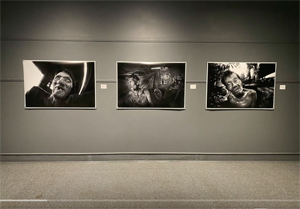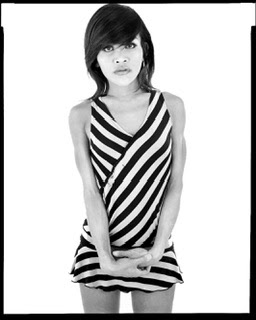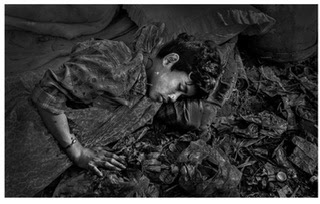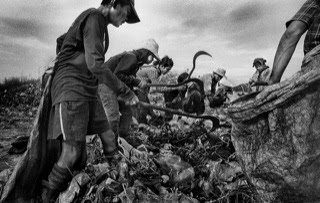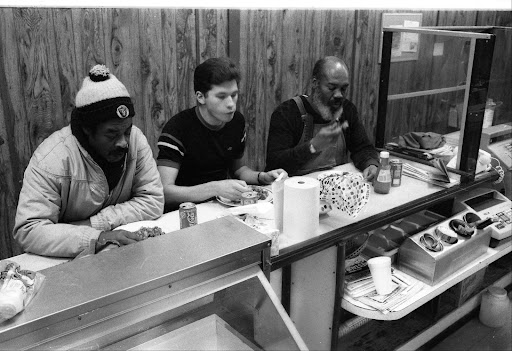
December 18, 2007
A Big Gift for the Met: The Arbus Archives
By CAROL VOGEL
Two years ago gallerygoers had a chance to discover the personal side of Diane Arbus in a retrospective at the Metropolitan Museum of Art. In addition to the portraits that made her famous — powerfully unsettling photographs of dwarfs, transvestites and everyday people — the Met filled librarylike rooms with her photographic equipment, pages from her diaries, books from her home and studio and family pictures.
Now the photographer’s estate has presented this intimate chronicle of Arbus’s life — her complete archives — to the Met as a gift, along with hundreds of early and unique photographs; negatives and contact prints of 7,500 rolls of film; and hundreds of glassine print sleeves that she personally annotated before her death by suicide in 1971.
At the same time, the museum has bought 20 of Arbus’s most important photographs, including “Russian Midget Friends in a Living Room on 100th Street, N.Y.C.” from 1963 and “Woman with a Veil on Fifth Avenue, N.Y.C.” from 1968, from the Fraenkel Gallery in San Francisco, which represents her estate. While the Met declined to say what it paid for the photographs, experts say they are worth at least $5 million. The gift of the archive is impossible to value, experts said.
Jeff L. Rosenheim, curator in the Met’s department of photographs, predicted that the archive would be an enormous boon to scholars. “Generally this kind of material doesn’t survive the artist,” he said.
Unlike the belongings of artists who fade gradually from view, which are sometimes scattered, pilfered or lost, Arbus’s effects were in some ways frozen in time when she committed suicide at 48. Quickly her life began to acquire a cult status paralleling that of her photography. (After her death her daughters, Amy and Doon, looked after their mother’s estate.
Born into a wealthy family in New York, she married Allan Arbus when she was 18. The two ran a fashion photography business until 1959, when they began working on independent projects, many of which eventually found their way into magazines like Esquire and Harper’s Bazaar.
What makes her portraits so unusual and so popular, as she once said, is that “nothing is ever what it seems.” She photographed subjects from nudists and freaks and carnival performers to just plain faces on the street that compelled or intrigued her.
“These pictures ask more questions than they answer,” Mr. Rosenheim said. “When you look at them, you almost feel as though you are having an interaction with the subject and the picture maker simultaneously. You are in a place where there is a lot of intimacy being shared.”
Unlike many photographers with whom she overlapped, like Henri Cartier Bresson and Robert Frank, Arbus would often meet a subject and form a long relationship, the diaries and date books show. It could take 10 years for her to produce her best photographs of that subject.
“Most of the artists of the period who photographed their subjects did not know them at all and did not wish to know them,” Mr. Rosenheim said. “But Arbus worked so differently — she was a medium for a lot of people.” He cited the famous 1970 portrait of Eddie Carmel, a performer who was known over the years as the “World’s Biggest Cowboy” and later the Jewish giant. “That picture took 10 years to gestate,” Mr. Rosenheim said.
Arbus was also very much a New York artist: Many of her subjects were people she had met in Central Park. “It couldn’t be closer to home,” Mr. Rosenheim said of the Met, a stone’s throw from her old haunts.
For years the museum has pushed to expand its modern photography holdings. In 1994 it captured the archive of Walker Evans, including some 30,000 black-and-white negatives, 10,000 color transparencies, motion picture film from the late 1920s to the 1970s, original manuscripts, diaries, recordings of interviews and lectures and his personal library.
That archive also included ephemera like road signs and driftwood that Evans collected on walks on the beach near his Connecticut home toward the end of his life, when he was too infirm to hold a camera. “He also had an enormous correspondence and volumes of writings,” Mr. Rosenheim said. “But his life was much longer than Arbus’s.”
Mr. Rosenheim said it took six years to catalog, conserve and make sense of the Evans archive. Even though he was one of the curators who helped organize “Diane Arbus Revelations,” the traveling exhibition that stopped at the Met in 2005, he said he had not really had the chance to “dig deep” into her archival material, which starts in 1923.
His ultimate goal, he said, was “to present in an unfettered way the direct material from which Arbus created her work.” Once the materials are cataloged, scholars will be able to have access to them.
“I need time to sit there with these volumes,” Mr. Rosenheim said.





